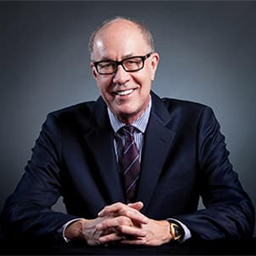For the final CEOtoCEO event for 2019, Glen Hiemstra provided attendees with a look back on his 40-year career as a futurist, highlighting the people and ideas that inspired him to devote his professional life to exploring future possibilities, and helping industry leading businesses and executives create actionable plans to meet them confidently.
He also described the necessary mindset for successful future-focused leaders, and outlined the key opportunities for future enterprise, as well as the future's single greatest challenge.
Hiemstra began with his recent observation that at the age of 70, it had been 40 years since he had given his first speech as a futurist. He even produced the original handwritten notes for that speech, which he had recently discovered in his archives.
While studying at Whitworth University, he heard President Ed Lindaman speak. Lindaman had been a director of programming at Rockwell who worked on the Apollo program, as well as a founding member of the World Future Society. It was during this speech when Hiemstra first heard the word "futurist", as Lindaman announced himself as a futurist. Lindaman became a personal mentor and inspiration to Hiemstra.
To emphasize why thinking of the future was important, Hiemstra offered some insight into how it is an intrinsic part of being human. He began with a quote taken from an organizational manager which Northwest poet David Whyte was deeply moved to mention in one of his books:
"Ten years ago, I turned my face for a moment, and it became my life."
Hiemstra found this short passage particularly profound, and a lesson for how lack of thinking in the future can result in arriving helplessly in a future that is less than preferable. He mentioned the concept of humans being "time-binders' "uniquely capable of learning from the past, living in the present, and placing themselves the future. A quote from Edward Lindaman motivated Hiemstra's commitment to future thinking:
"If you don't go far enough back in memory or far enough ahead in hope, your future will be impoverished."
His practical advice for leaders was that those who hoped to be relevant in the future should be spending a significant portion of their time doing long-term strategic planningâ€"as much as 20 percent of their time for certain fields. This planning needs to observe the following:
- Change takes time.
- Leaders need to look ahead 20 years or moreâ€"5 years is not enough.
- Companies wait too long to take their "future look".
He warned that the temptation for many who try to envision the future to create strategies is to snap back into the present paradigm conceptualizing a valid future possibility but placing it in the context of the present mode of operating or category. Hiemstra urged the importance to "break the paradigm" of your industry or category. He gave as an example the Tesla "pickup truck" which was neither car nor truck, and was clearly designed with the intent to break convention to anticipate the future unlike Tesla's cars, which feature completely conventional designs.
Hiemstra offered several examples of companies that utilized long-range planning to create futures which prepared for emerging challenges and even drove expansion, including Fuji, which looked ahead 25 years to transform itself from a company focused on film photography to a large corporation comprising medical imaging, copy equipment, and cosmetics companies. Hiemstra contrasted Fuji's success in looking forward to Kodak, which had ironically invented digital imaging in the 1970s, but failed to look beyond its category as a photography company, and ended up filing for bankruptcy early in the 21st century. Illustrating the extent to which some companies embrace the futurist mindset, Boeing put together a 3-day symposium for their executives and invited NASA scientists and science fiction writers. They looked ahead an ambitious 100 years to envision Boeing's involvement in the immense off-world economy of the future, which according to NASA will eventually equal the entire economy of the earth.
Hiemstra offered Edward Lindaman's three essential questions for the effective planning of successful management of future changes:
- What is probable?
- What is possible?
- What is preferred?
Neglecting to consider all three of these questions would not result in what Hiemstra has termed the "preferred future".
He then relayed to the audience the four trillion-dollar opportunities of the future that were predicted by NASA Langley Research Director, Dennis Bushnell:
- The Electrification of Transportation including airplanes
- Halophytes (Plants that can grow in salt water a potential food source of the future)
- The DIY Revolution self-sufficient populaces producing everything they consume
- The Space Economy including travel and resource mining
Successful enterprises in any of these markets would require long-term future conceptualization, but would also have to consider their disruptive potential to existing conventions and industries.
His presentation also touched on what may be the greatest challenge of the future: a declining population. As urbanization progresses throughout the world and women defer starting families to focus on education and career, the family size is reducing and the fertility rate of countries across the globe is shrinking.
Hiemstra concluded with a few excerpts from poet Rainer Maria Rilke, which reminded the audience that future awareness was also a matter of personal and philosophical import:
". . . the future enters us . . . to be transformed in us, long before it happens."
"Do not now seek the answers . . . Live the questions now."













